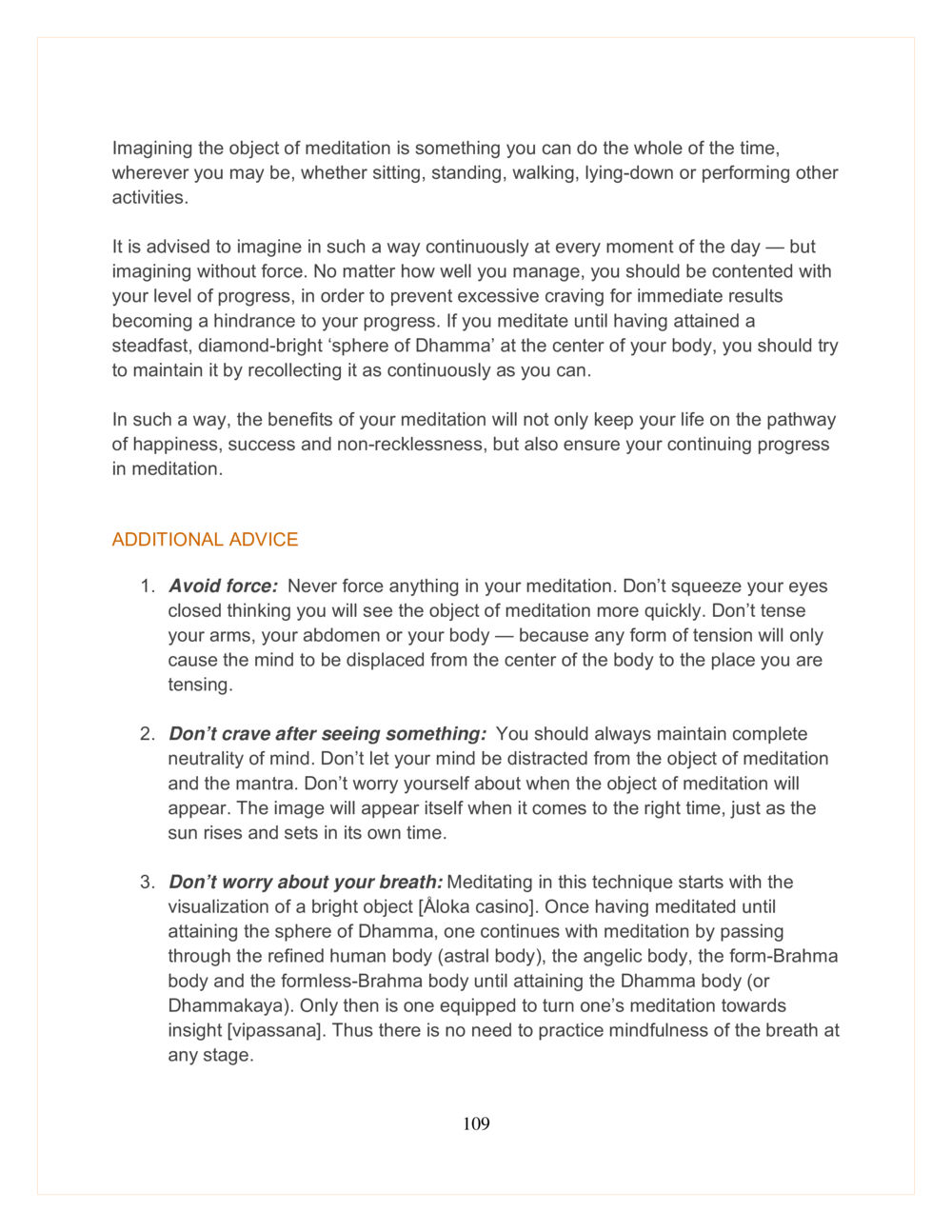Meditation Techniques for Continuous Mindfulness : หน้า 109/115
DMC Translor’s handbook : หน้า 109/115 Learn to meditate effectively and continuously in your daily life without force or craving for immediate results.
3 ครั้ง

สรุปเนื้อหา
การทำสมาธิสามารถทำได้ตลอดเวลา ไม่ว่าคุณจะอยู่ในท่าใด โดยการจินตนาการวัตถุของการทำสมาธิอย่างต่อเนื่องและไม่ต้องบังคับ อย่าหวังผลลัพธ์ในทันทีเพื่อป้องกันการรู้สึกไม่พอใจ ที่สำคัญคือการรักษาสภาวะจิตใจเป็นกลาง ในการทำสมาธิให้ยอดเยี่ยมและรักษาระดับจิตสำนึกที่ดีไปตลอดชีวิต เพื่อให้เกิดความสุขและความสำเร็จ โดยมีวิธีการที่แนะนำเช่น หลีกเลี่ยงการบังคับหรือเครียดในขณะทำสมาธิ และไม่ต้องกังวลเกี่ยวกับการหายใจหรือผลลัพธ์ เพียงแค่คอยสังเกตและยอมรับประสบการณ์ของตัวเองตามธรรมชาติ
หัวข้อประเด็น
-Continuous mindfulness
-Techniques for meditation
-Avoiding force and tension
-Maintaining neutrality in mind
-Visualization in meditation
ข้อความต้นฉบับในหน้า
Imagining the object of meditation is something you can do the whole of the time, wherever you may be, whether sitting, standing, walking, lying-down or performing other activities.
It is advised to imagine in such a way continuously at every moment of the day — but imagining without force. No matter how well you manage, you should be contented with your level of progress, in order to prevent excessive craving for immediate results becoming a hindrance to your progress. If you meditate until having attained a steadfast, diamond-bright ‘sphere of Dhamma’ at the center of your body, you should try to maintain it by recollecting it as continuously as you can.
In such a way, the benefits of your meditation will not only keep your life on the pathway of happiness, success and non-recklessness, but also ensure your continuing progress in meditation.
ADDITIONAL ADVICE
1. Avoid force: Never force anything in your meditation. Don’t squeeze your eyes closed thinking you will see the object of meditation more quickly. Don’t tense your arms, your abdomen or your body — because any form of tension will only cause the mind to be displaced from the center of the body to the place you are tensing.
2. Don’t crave after seeing something: You should always maintain complete neutrality of mind. Don’t let your mind be distracted from the object of meditation and the mantra. Don’t worry yourself about when the object of meditation will appear. The image will appear itself when it comes to the right time, just as the sun rises and sets in its own time.
3. Don’t worry about your breath: Meditating in this technique starts with the visualization of a bright object [Āloka casino]. Once having meditated until attaining the sphere of Dhamma, one continues with meditation by passing through the refined human body (astral body), the angelic body, the form-Brahma body and the formless-Brahma body until attaining the Dhamma body (or Dhammakaya). Only then is one equipped to turn one’s meditation towards insight [vipassana]. Thus there is no need to practice mindfulness of the breath at any stage.
Tags : #การทำสมาธิ #สมาธิตลอดเวลา #การฝึกจิต
หน้าหนังสือทั้งหมด
หนังสือที่เกี่ยวข้อง
Load More



















































































































